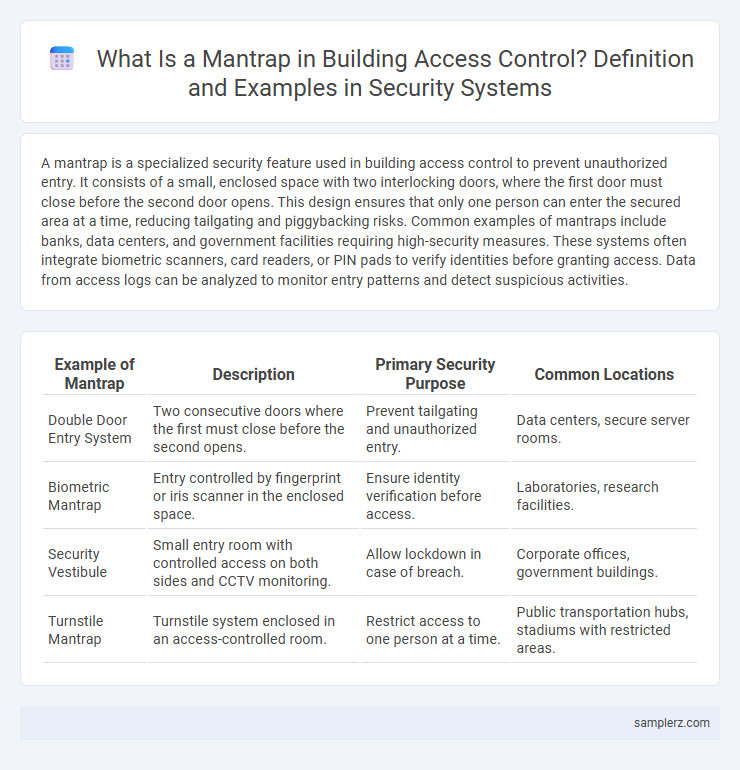A mantrap is a specialized security feature used in building access control to prevent unauthorized entry. It consists of a small, enclosed space with two interlocking doors, where the first door must close before the second door opens. This design ensures that only one person can enter the secured area at a time, reducing tailgating and piggybacking risks. Common examples of mantraps include banks, data centers, and government facilities requiring high-security measures. These systems often integrate biometric scanners, card readers, or PIN pads to verify identities before granting access. Data from access logs can be analyzed to monitor entry patterns and detect suspicious activities.
Table of Comparison
| Example of Mantrap | Description | Primary Security Purpose | Common Locations |
|---|---|---|---|
| Double Door Entry System | Two consecutive doors where the first must close before the second opens. | Prevent tailgating and unauthorized entry. | Data centers, secure server rooms. |
| Biometric Mantrap | Entry controlled by fingerprint or iris scanner in the enclosed space. | Ensure identity verification before access. | Laboratories, research facilities. |
| Security Vestibule | Small entry room with controlled access on both sides and CCTV monitoring. | Allow lockdown in case of breach. | Corporate offices, government buildings. |
| Turnstile Mantrap | Turnstile system enclosed in an access-controlled room. | Restrict access to one person at a time. | Public transportation hubs, stadiums with restricted areas. |
Introduction to Mantraps in Building Access Security
Mantraps in building access security serve as controlled entry points designed to prevent unauthorized access by allowing only one person to enter at a time. These physical security barriers typically consist of two interlocking doors, where the first door must close before the second one opens, ensuring identity verification and reducing tailgating risks. Widely used in high-security environments like data centers and corporate offices, mantraps enhance access control by integrating biometric scanners, card readers, or PIN pads for multifactor authentication.
Understanding the Purpose of Mantraps
Mantraps are physical security barriers designed to control and monitor access between two secure areas, typically consisting of two interlocking doors where one must close before the other opens. They prevent tailgating and unauthorized entry by ensuring only one person passes through at a time, enhancing security in sensitive environments like data centers or corporate offices. Mantraps also facilitate identity verification through biometric scanners or card readers, reinforcing access control protocols to protect valuable assets.
Types of Mantraps Used in Modern Buildings
Types of mantraps used in modern buildings include mechanical, electronic, and biometric mantraps, each designed to enhance security by controlling and verifying access. Mechanical mantraps typically use interlocking doors that prevent simultaneous opening, while electronic mantraps integrate card readers or PIN pads for credential authentication. Biometric mantraps utilize fingerprint, iris, or facial recognition technology to ensure access is granted only to authorized individuals, offering the highest level of security in sensitive environments.
Example of Physical Mantrap Installations
Physical mantrap installations feature two interlocking doors that control access to secure areas, ensuring only one person can enter at a time. Common examples include card reader-controlled vestibules in high-security offices and biometric scanners combined with turnstiles in data centers. These systems prevent tailgating and unauthorized access by creating a controlled buffer zone between public and restricted spaces.
Case Study: Mantrap Deployment in Data Centers
Mantraps in data centers enhance physical security by controlling access through a dual-door system that verifies authentication before entry. A case study of a financial institution revealed that implementing mantraps reduced unauthorized access attempts by 80% within six months. Integration of biometric scanners and RFID card readers within the mantrap ensures multi-factor authentication, significantly strengthening data protection protocols.
Mantraps in Government and Military Facilities
Mantraps in government and military facilities serve as critical security barriers preventing unauthorized access by controlling the movement between two secure areas. These physical security features are designed to verify identities through biometric scanners, key cards, or PIN codes before granting entry, significantly reducing the risk of tailgating or forced entry. Integrating mantraps with surveillance cameras and alarm systems enhances the ability to monitor and respond to security breaches promptly within sensitive installations.
Integrating Mantraps with Access Control Systems
Integrating mantraps with access control systems enhances building security by ensuring only authorized personnel pass through secured entry points. These systems use biometric or card-based authentication before allowing access to the mantrap, preventing tailgating and unauthorized entry. Real-time monitoring and automated alerts within the integration enable swift response to security breaches or attempts at forced entry.
Common Design Features of Effective Mantraps
Effective mantraps in building access commonly feature interlocking doors that prevent both from being open simultaneously, biometric or card-based authentication systems for user verification, and integrated surveillance cameras to monitor entry. These design elements create a secure buffer zone that controls access, reducing unauthorized entry and tailgating risks. Robust mantrap designs often include alarm systems triggered by forced entry attempts and emergency override capabilities to balance security with safety compliance.
Benefits of Using Mantraps for Threat Mitigation
Mantraps enhance building security by creating a controlled access point that prevents unauthorized entry and tailgating, significantly reducing the risk of intruders bypassing secure areas. These physical barriers enable robust identity verification through biometric scanners or card readers, ensuring that only authorized personnel gain access. Implementing mantraps strengthens threat mitigation by providing a secure buffer zone where potential security breaches can be detected and responded to promptly.
Best Practices for Implementing Mantraps in Buildings
Effective mantrap implementation in buildings involves integrating biometric authentication and anti-tailgating sensors to enhance access control precision. Positioning mantraps at critical entry points, such as data centers or executive offices, ensures restricted areas maintain the highest security levels. Routine testing and employee training on mantrap protocols prevent unauthorized access and minimize operational disruptions.

example of mantrap in building access Infographic
 samplerz.com
samplerz.com